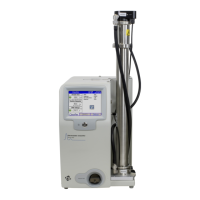B-4 Electrostatic Classifier Model 3082 and SMPS Spectrometer Model 3938
The impaction plate deflects the flow to form a 90° bend in the streamlines.
Particles with sufficient inertia are unable to follow the streamlines and
impact on the plate. Smaller particles follow the streamlines, avoid contact
with the plate and exit the impactor. The impactor is used in the SMPS
system to remove particles larger than a known aerodynamic size in order
to eliminate their contribution to multiply charged aerosols. The
aerodynamic particle size at which the particles are separated is called the
cut-point diameter. The cut-point diameter is a function of the impactor flow
rate and nozzle diameter. Equation B-1, below, is used to calculate the cut-
point diameter. The Cunningham Slip Correction C in Equation B-1 is a
function of the particle diameter; therefore this equation must be solved by
iteration.
Equation B-1
where:
D
50
= particle cut-point diameter (cm, 50% cut efficiency)
Stk
50
= Stokes number for 50% collection efficiency = 0.23
= particle density (g/cm
3
)
Q= volumetric flow rate (cm
3
/s)
C= Cunningham Slip Correction
Kn
expKn1C
= 1.165,
= 0.483,
= 0.997 Kn = Knudsen Number (Kim et al., 2005)
= gas mean free path
η = gas viscosity (g/(cm·s))
W = nozzle diameter (cm)
The Stokes number is a dimensionless parameter that characterizes
impaction. Values and equations for the gas mean free path and the
dynamic gas viscosity are described in the Particle Mobility Theory section.

